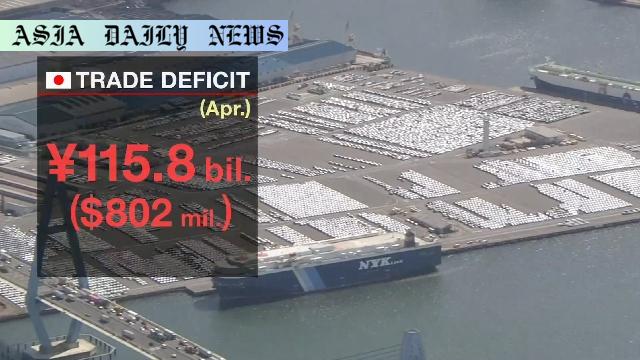Trade Deficit – Japan marks the first trade deficit in three months, signaling economic challenges amid export and import fluctuations.
Trade deficit amounted to 115.8 billion yen (~$800 million).
Exports grew by 2% year-over-year to 9.15 trillion yen.
Car exports to the US declined due to yen appreciation.
Imports fell 2.2%, influenced by cheaper coal and crude oil.

Japan’s Growing Trade Deficit and the Contributing Factors
Japan recorded its first trade deficit in three months during April 2023, highlighting a set of economic challenges that continue to pressure the nation’s economy. According to the Finance Ministry’s report, the deficit stood at 115.8 billion yen (approximately $800 million USD). This development reverses the trend of positive trade balance observed in the earlier months of the year and paints a concerning picture for policymakers monitoring the economic effects of international trade policies and global commodity price shifts.
One of the notable factors leading to this trade shortfall is the fluctuation in both export and import markets. Despite a 2% year-on-year growth in exports totaling 9.15 trillion yen (~$63.5 billion), the impact of a stronger yen has begun to weigh heavily on certain sectors. Automobile exports to the United States—a key driver of Japan’s economic engine—declined for the first time in four months, with shipment values dropping 4.8%. This underscores the challenges posed by volatile currency markets, where a more robust yen reduces the competitiveness of Japanese goods overseas.
On the flip side, imports recorded a decrease of 2.2% in yen terms, amounting to approximately 64 billion dollars. This decline was predominantly driven by a fall in energy prices, particularly coal and crude oil, both of which are central to Japan’s energy consumption. While cheaper energy imports might seem like a boon, when paired with sluggish export performance, they underscore the complex interplay of global market dynamics that challenge Japan’s trade-dependent economy.
Impact of US Tariffs and Domestic Challenges
The data also reflects lingering uncertainties tied to the US trade policies under the Trump administration. Specifically, additional tariffs imposed by the United States have created ripples that further amplify existing tensions in international trade corridors. For Japan, the US is one of its major trading partners, and any shifts in American policy can have outsized repercussions on Japanese exports.
Coupled with such external pressures, Japan is also navigating several internal structural issues. The recent decline in automobile exports represents a warning signal to broader industrial sectors, many of which are already grappling with labor shortages and lukewarm domestic demand. Furthermore, the increasing shift in global energy markets towards renewables emphasizes Japan’s dependence on fossil fuel imports, creating a long-term vulnerability.
Outlook for the Japanese Economy
As Japan works to stabilize its economic footing, government policymakers are expected to adopt a mix of monetary and fiscal measures to encourage growth. Whether it involves adjustments in forex policies to stabilize the yen or crafting trade agreements to offset the impact of tariffs, the coming months are expected to be pivotal for Japan’s broader economic health.
In conclusion, while the immediate trade deficit may seem manageable, it illustrates a concerning trend where external global forces and internal vulnerabilities interplay. For an economy traditionally reliant on exports, regaining a solid trade surplus will require navigating increasingly complex global landscapes of competition, regulation, and innovation.



Commentary
Understanding Japan’s Trade Deficit in a Global Context
The recent news about Japan’s trade deficit raises important questions about the state of global trade and its intertwined complexity. This deficit, amounting to 115.8 billion yen ($800 million), comes at a time when economies worldwide are grappling with inflation, volatile currency values, and shifting trade policies. For Japan, a nation that has long relied on its export-driven economy, the pressures introduced by these factors are even more pronounced.
One cannot overlook the role of international trade policies, particularly the tariffs implemented by the United States. Although these measures were introduced with the intent of protecting domestic industries, they inevitably create ripple effects that hamper global trade dynamics. Japan, being one of the top trading nations, finds itself at the nexus of such disruptions. The 4.8% decline in automobile exports to the United States serves as a stark reminder of how even robust sectors can buckle under external stressors.
The Crucial Role of Energy Prices
Another aspect worth exploring is the impact of energy prices on Japan’s overall trade balance. While the decline in coal and crude oil prices might appear positive at first glance, it is a double-edged sword. Cheaper imports are beneficial, but a consistent downward trend in import prices also reflects broader instabilities within commodity markets. Given Japan’s reliance on energy imports, a more sustainable energy policy could mitigate such vulnerabilities over the long term.
In conclusion, Japan’s trade deficit highlights the multifaceted challenges of modern global economics. It underscores the necessity for proactive trade policies, innovation in export sectors, and long-term strategies that prioritize resilience over short-term fixes. By navigating these complexities effectively, Japan can continue to maintain its status as an economic powerhouse, even amidst adversity.